GreatExam dumps for 70-412 exam are written to the highest standards of technical accuracy, provided by our certified subject matter experts and published authors for development. We guarantee the best quality and accuracy of our products. We hope you pass the exams successfully with our practice test. With our Microsoft 70-412 practice test, you will pass your exam easily at the first attempt. You can also enjoy 365 days free update for your product.
QUESTION 101
You have a server named Server1 that runs Windows Server 2012 R2.
Windows Server 2012 R2 is installed on volume C.
You need to ensure that Safe Mode with Command Prompt loads the next time Server1 restarts. Which tool should you use?
A. The Restart-Server cmdlet
B. The Bootcfg command
C. The Restart-Computer cmdlet
D. The Bcdedit command
Answer: D
Explanation:
A. Restart-Server is not a CMDLET
B. modifies the Boot.ini file
C. Restarts computer
D. Boot Configuration Data (BCD) files provide a store that is used to describe boot applications and boot application settings.
http://support.microsoft.com/kb/317521
http://technet.microsoft.com/en-us/library/hh849837.aspx
http://technet.microsoft.com/en-us/library/cc731662(v=ws.10).aspx
You can see with msconfig tool that boot options have changed as follows:
NOTE: Alternate Shell may be used
After reboot you should remove the safeboot option using bcdedit:
– bcdedit /deletevalue safeboot
QUESTION 102
Your network contains an Active Directory domain named contoso.com.
The domain contains a server named Server1 that runs Windows Server 2012 R2.
Server1 has the Active Directory Certificate Services server role installed and is configured to support key archival and recovery.
You create a new Active Directory group named Group1.
You need to ensure that the members of Group1 can request a Key Recovery Agent certificate. The solution must minimize the permissions assigned to Group1.
Which two permissions should you assign to Group1? (Each correct answer presents part of the solution. Choose two.)
A. Read
B. Auto enroll
C. Write
D. Enroll
E. Full control
Answer: AD
Explanation:
* In Template, type a new template display name, and then modify any other optional properties as needed.
On the Security tab, click Add, type the name of the users you want to issue the key recovery agent certificates to, and then click OK. Under Group or user names, select the user names that you just added. Under Permissions, select the Read and Enroll check boxes, and then click OK.
QUESTION 103
Your network contains two Web servers named Server1 and Server2. Server1 and Server2 are nodes in a Network Load Balancing (NLB) cluster.
You configure the nodes to use the port rule shown in the exhibit. (Click the Exhibit button.)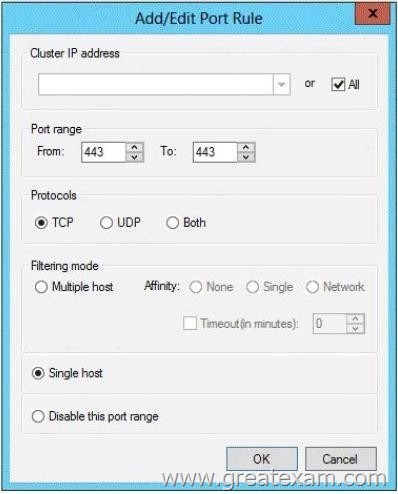
You need to configure the NLB cluster to meet the following requirements:
– HTTPS connections must be directed to Server1 if Server1 is available.
– HTTP connections must be load balanced between the two nodes.
Which three actions should you perform? (Each correct answer presents part of the solution. Choose three.)
A. From the host properties of Server1, set the Handling priority of the existing port rule to 2.
B. From the host properties of Server1, set the Handling priority of the existing port rule to 1.
C. From the host properties of Server2, set the Priority (Unique host ID) value to 1.
D. Create a port rule for TCP port 80. Set the Filtering mode to Multiple host and set the Affinity to None.
E. From the host properties of Server2, set the Handling priority of the existing port rule to 2.
F. Create an additional port rule for TCP port 443. Set the Filtering mode to Multiple host and set the Affinity
to Single.
Answer: BDE
Explanation:
Handling priority: When Single host filtering mode is being used, this parameter specifies the local host’s priority for handling the networking traffic for the associated port rule. The host with the highest handling priority (lowest numerical value) for this rule among the current members of the cluster will handle all of the traffic for this rule. The allowed values range from 1, the highest priority, to the maximum number of hosts allowed (32). This value must be unique for all hosts in the cluster.
E (not C): Lower priority (2) for Server 2.
D: HTTP is port 80.
Multiple hosts. This parameter specifies that multiple hosts in the cluster handle network traffic for the associated port rule.
This filtering mode provides scaled performance in addition to fault tolerance by distributing the network load among multiple hosts.
You can specify that the load be equally distributed among the hosts or that each host handle a specified load weight. Reference:
Network Load Balancing parameters
QUESTION 104
Your network contains two Active Directory forests named contoso.com and litwareinc.com.
A two- way forest trusts exists between the forest. Selective authentication is enabled on the trust. The contoso.com forest contains a server named Server1.
You need to ensure that users in litwareinc.com can access resources on Server1.
What should you do?
A. Install Active Directory Rights Management Services on a domain controller in contoso.com.
B. Modify the permission on the Server1 computer account.
C. Install Active Directory Rights Management Services on a domain controller in litwareinc.com.
D. Configure SID filtering on the trust.
Answer: B
Explanation:
http://technet.microsoft.com/en-us/library/cc772808(v=ws.10).aspx
QUESTION 105
Your network contains an Active Directory domain named contoso.com. The domain contains two member servers named Server1 and Server2. All servers run Windows Server 2012 R2.
Server1 and Server2 have the Failover Clustering feature installed.
The servers are configured as nodes in a failover cluster named Cluster1.
You add two additional nodes to Cluster1.
You have a folder named Folder1 on Server1 that contains application data.
You plan to provide continuously available access to Folder1.
You need to ensure that all of the nodes in Cluster1 can actively respond to the client requests for Folder1.
What should you configure?
A. Affinity-None
B. Affinity-Single
C. The cluster quorum settings
D. The failover settings
E. A file server for general use
F. The Handling priority
G. The host priority
H. Live migration
I. The possible owner
J. The preferred owner
K. Quick migration
L. the Scale-Out File Server
Answer: L
Explanation:
http://technet.microsoft.com/en-us/library/hh831349.aspx
Scale-Out File Server for application data (Scale-Out File Server)
This clustered file server is introduced in Windows Server 2012 R2 and lets you store server application data, such as Hyper-V virtual machine files, on file shares, and obtain a similar level of reliability, availability, manageability, and high performance that you would expect from a storage area network.
All file shares are online on all nodes simultaneously.
File shares associated with this type of clustered file server are called scale-out file shares.
This is sometimes referred to as active-active.
QUESTION 106
Information and details provided in a question apply only to that question.
Your network contains an Active Directory domain named contoso.com.
The domain contains two member servers named Server1 and Server2. All servers run Windows Server 2012 R2. Server1 and Server2 have the Network Load Balancing (NLB) feature installed.
The servers are configured as nodes in an NLB cluster named Cluster1.
Cluster1 hosts a secure web application named WebApp1.
WebApp1 saves user state information locally on each node.
You need to ensure that when users connect to WebApp1, their session state is maintained. What should you configure?
A. Affinity-None
B. Affinity-Single
C. The cluster quorum settings
D. The failover settings
E. A file server for general use
F. The Handling priority
G. The host priority
H. Live migration
I. The possible owner
J. The preferred owner
K. Quick migration
L. the Scale-Out File Server
Answer: B
Explanation:
http://technet.microsoft.com/en-us/library/bb687542.aspx
QUESTION 107
Hotspot Question
Your network contains an Active Directory domain named contoso.com.
You install the IP Address Management (IPAM) Server feature on a server named Server1 and select Manual as the provisioning method.
The IPAM database is located on a server named SQL1.
You need to configure IPAM to use Group Policy Based provisioning.
What command should you run first? To answer, select the appropriate options in the answer area.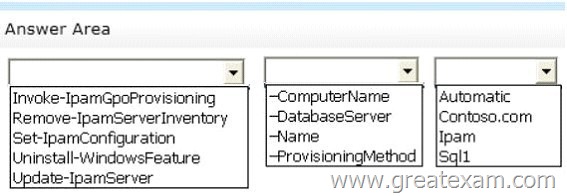
Answer: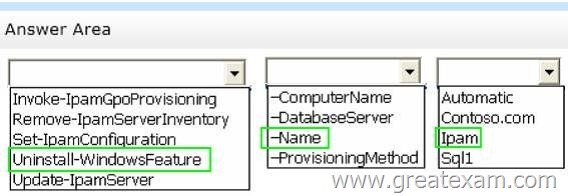
Explanation:
“You cannot change the provisioning method for the current installation of IPAM Server after it has been selected.
To change the provisioning method, you must uninstall and reinstall IPAM Server on the computer.”
http://technet.microsoft.com/en-us/library/38e4074a-3caa-4eed-9b11-c4d77741bbdd#choose_method
QUESTION 108
You have an Active Directory Rights Management Services (AD RMS) cluster.
You need to prevent users from encrypting new content.
The solution must ensure that the users can continue to decrypt content that was encrypted already.
Which two actions should you perform? (Each correct answer presents part of the solution.
Choose two.)
A. From the Active Directory Rights Management Services console, enable decommissioning.
B. From the Active Directory Rights Management Services console, create a user exclusion policy.
C. Modify the NTFS permissions of %systemdrive%\inetpub\wwwroot\_wmcs\licensing.
D. Modify the NTFS permissions of %systemdrive%\inetpub\wwwroot\_wmcs\decommission.
E. From the Active Directory Rights Management Services console, modify the rights policy templates.
Answer: AD
Explanation:
The answer should be A & D
Decommission AD RMS
http://technet.microsoft.com/en-us/library/cc754967.aspx
Decommission AD RMS Root Cluster
http://technet.microsoft.com/en-us/library/cc771071(v=ws.10).aspx
If you were to create a user exclusion policy, then that would “exclude” them from being able to access certain entities. Therefore, not being able to access decrypted content to begin with.
QUESTION 109
Drag and Drop Question
Your network contains an Active Directory domain named contoso.com.
All file servers in the domain run Windows Server 2012 R2.
The computer accounts of the file servers are in an organizational unit (OU) named OU1.
A Group Policy object (GPO) named GPO1 is linked to OU1.
You plan to modify the NTFS permissions for many folders on the file servers by using central access policies.
You need to identify any users who will be denied access to resources that they can currently access once the new permissions are implemented.
In which order should you Perform the five actions?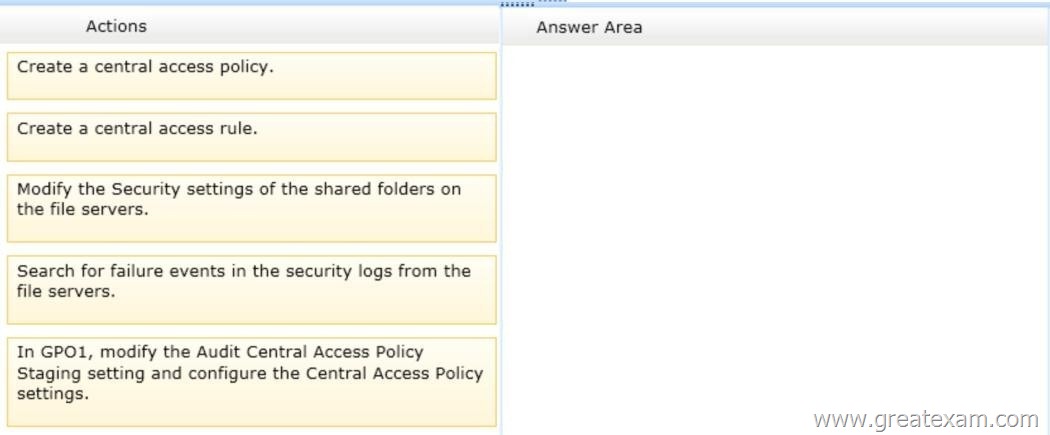
Answer: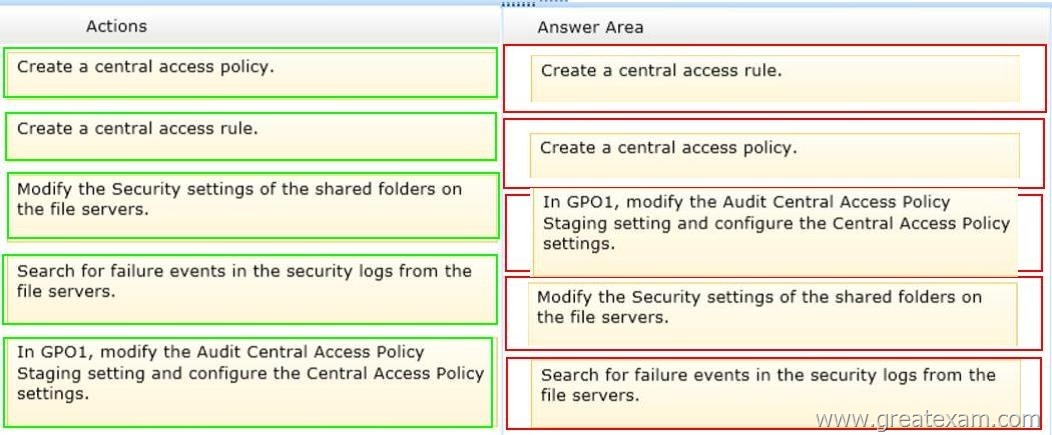
Explanation:
I hate steps like this because you can create a rule first and then the policy, or you can create the policy and create the rule during the creation of the policy.
Either way I’m going to go with creating the policy first, and then the rule.
QUESTION 110
You have a file server named Server1 that runs Windows Server 2012 R2.
Data Deduplication is enabled on drive D of Server1.
You need to exclude D:\Folder1 from Data Deduplication.
What should you configure?
A. Disk Management in Computer Management
B. File and Storage Services in Server Manager
C. the classification rules in File Server Resource Manager (FSRM)
D. the properties of D:\Folder1
Answer: B
Explanation:
B. Data deduplication exclusion on a Volume are set from File & Storage Services, Server Manager or PowerShell
http://technet.microsoft.com/en-us/library/hh831434.aspx
QUESTION 111
You manage an environment that has many servers.
The servers run Windows Server 2012 R2 and use iSCSI storage.
Administrators report that it is difficult to locate available iSCSI resources on the network.
You need to ensure that the administrators can locate iSCSI resources on the network by using a central repository.
Which feature should you deploy?
A. The iSCSI Target Server role service
B. The iSNS Server service feature
C. The Windows Standards-Based Storage Management feature
D. The iSCSI Target Storage Provider feature
Answer: B
Explanation:
A. iSNS facilitates automated discovery, management, and configuration of iSCSI and Fibre
Channel devices (using iFCP gateways) on a TCP/IP network.
C. Windows Server 2012 R2 enables storage management that is comprehensive and fully
scriptable, and administrators can manage it remotely
D. iSCSI Target Server enables you to network boot multiple computers from a single operating system image that is stored in a centralized location
http://technet.microsoft.com/en-us/library/cc772568.aspx
http://technet.microsoft.com/en-us/library/hh831751.aspx
http://technet.microsoft.com/en-us/library/dn305893.aspx
QUESTION 112
Your network contains an Active Directory domain named contoso.com.
The network contains a file server named Server1 that runs Windows Server 2012 R2.
You create a folder named Folder1.
You share Folder1 as Share1. The NTFS permissions on Folder1 are shown in the Folder1 exhibit. (Click the Exhibit button.)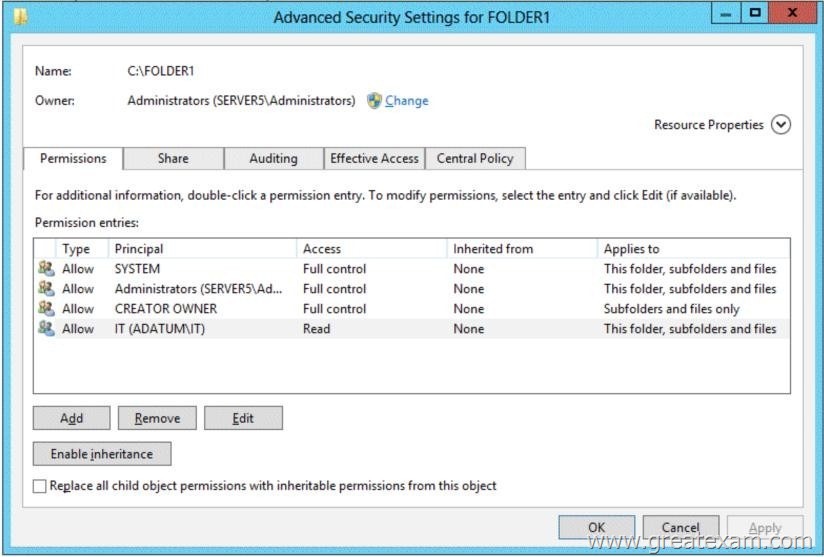
The Everyone group has the Full control Share permission to Folder1.
You configure a central access policy as shown in the Central Access Policy exhibit. (Click the Exhibit button.)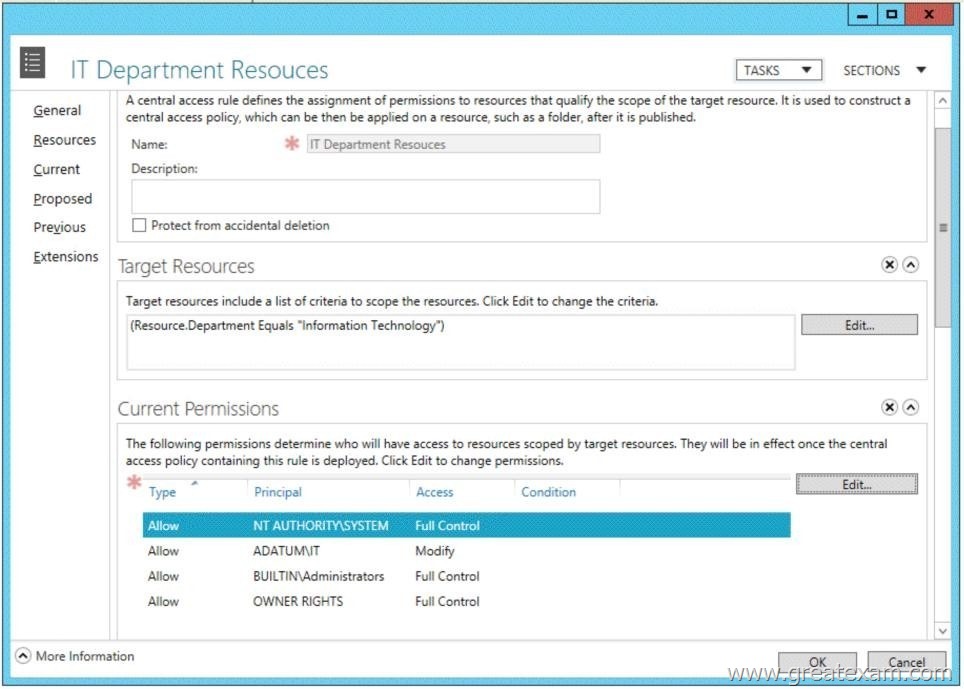
Members of the IT group report that they cannot modify the files in Folder1.
You need to ensure that the IT group members can modify the files in Folder1.
The solution must use central access policies to control the permissions.
Which two actions should you perform? (Each correct answer presents part of the solution. Choose two.)
A. On the Classification tab of Folder1, set the classification to Information Technology.
B. On the Security tab of Folder1, add a conditional expression to the existing permission entry for
the IT group.
C. On Share1, assign the Change Share permission to the IT group.
D. On the Security tab of Folder1, remove the permission entry for the IT group.
E. On the Security tab of Folder1, assign the Modify permission to the Authenticated Users group.
Answer: AE
Explanation:
Central access policies for files enable organizations to centrally deploy and manage authorization policies that include conditional expressions that use user groups, user claims, device claims, and resource properties.
(Claims are assertions about the attributes of the object with which they are associated).
For example, to access high-business-impact (HBI) data, a user must be a full-time employee, obtain access from a managed device, and log on with a smart card.
These policies are defined and hosted in Active Directory Domain Services (AD DS).
http://technet.microsoft.com/en-us/library/hh846167.aspx
QUESTION 113
You have a server named File1 that runs Windows Server 2012 R2.
Fuel has the File Server role service installed.
You plan to back up all shared folders by using Microsoft Online Backup.
You download and install the Microsoft Online Backup Service Agent on File1.
You need to ensure that you use Windows Server Backup to back up data to Microsoft Online Backup.
What should you do?
A. From Computer Management, add the File1 computer account to the Backup Operators group.
B. From Windows Server Backup, run the Register Server Wizard.
C. From a command prompt, run wbadmin.exe enable backup.
D. From the Services console, modify the Log On settings of the Microsoft Online Backup Service Agent.
Answer: B
Explanation:
A. Enables you to back up and restore your operating system, volumes, files, folders, and
applications from a command prompt.
B. To register a server for use with Windows Azure Backup you must run the register server wizard
http://technet.microsoft.com/en-us/library/hh831677.aspx
QUESTION 114
Your network contains an Active Directory domain named contoso.com.
You are creating a custom Windows Recovery Environment (Windows RE) image.
You need to ensure that when a server starts from the custom Windows RE image, a drive is mapped automatically to a network share.
What should you modify in the image?
A. startnet.cmd
B. Xsl-mApp1ngs.xml
C. Win.ini
D. smb.types.ps1xml
Answer: A
Explanation:
The best way to define what to start is using starnet.cmd
http://technet.microsoft.com/en-us/library/cc766521(v=ws.10).aspx
QUESTION 115
You have a file server named Server1 that runs a Server Core Installation of Windows Server 2012 R2.
You need to ensure that users can access previous versions of files that are shared on Server1 by using the Previous Versions tab.
Which tool should you use?
A. Diskpart
B. Wbadmin
C. Vssadmin
D. Storrept
Answer: C
Explanation:
A. Enables you to back up and restore your operating system, volumes, files, folders, and
applications from a command prompt.
B. DiskPart is a text-mode command interpreter that enables you to manage objects (disks, partitions, volumes, or virtual hard disks) by using scripts or direct input from a command prompt. C. The storrept command is installed with File Server Resource Manager and includes
subcommands for creating and managing storage reports and storage report tasks, as well as for configuring general administrative options for File Server Resource Manager.
D. Displays current volume shadow copy backups and all installed shadow copy writers and providers. To view the command syntax for any of the commands in the following table, click the command name.
http://technet.microsoft.com/en-us/library/cc754015(v=ws.10).aspx
http://technet.microsoft.com/en-us/library/cc770877(v=ws.10).aspx
http://technet.microsoft.com/en-us/library/cc753567(v=ws.10).aspx
http://technet.microsoft.com/en-us/library/cc754968.aspx
QUESTION 116
Your company has a main office and a branch office.
The main office contains a file server named Server1.
Server1 has the BranchCache for Network Files role service installed.
The branch office contains a server named Server2.
Server2 is configured as a BranchCache hosted cache server.
You need to preload the data from the file shares on Server1 to the cache on Server2.
You generate hashes for the file shares on Server1.
Which cmdlet should you run next?
A. Add-BCDataCacheExtension
B. Set-BCCache
C. Publish-BCFileContent
D. Export-BCCachePackage
Answer: D
Explanation:
The questions states that you already generate hashes (Publish-BCFileContent). Then it asks what you should run next.
https://technet.microsoft.com/en-us/library/jj572970.aspx
QUESTION 117
Your network contains an Active Directory domain named contoso.com.
The domain contains a main office and a branch office.
An Active Directory site exists for each office.
The domain contains two servers named Server1 and Server2 that run Windows Server 2012 R2.
Both servers have the DHCP Server server role installed.
Server1 is located in the main office site. Server2 is located in the branch office site.
Server1 provides IPv4 addresses to the client computers in the main office site.
Server2 provides IPv4 addresses to the client computers in the branch office site.
You need to ensure that if either Server1 or Server2 are offline, the client computers can still obtain IPv4 addresses.
The solution must meet the following requirements:
– The storage location of the DHCP databases must not be a single point of failure.
– Server1 must provide IPv4 addresses to the client computers in the branch office site only if Server2 is offline.
– Server2 must provide IPv4 addresses to the client computers in the main office site only if Server1 is offline.
Which configuration should you use?
A. load sharing mode failover partners
B. a failover cluster
C. hot standby mode failover partners
D. a Network Load Balancing (NLB) cluster
Answer: C
Explanation:
http://blogs.technet.com/b/teamdhcp/archive/2012/09/03/dhcp-failover-hot-standby-mode.aspx
http://blogs.technet.com/b/teamdhcp/archive/2012/09/03/dhcp-failover-hot-standby-mode.aspx
QUESTION 118
Your company has a main office and a branch office. The main office is located in Detroit.
The branch office is located in Seattle. The network contains an Active Directory domain named adatum.com. Client computers run either Windows 7 Enterprise or Windows 8 Enterprise.
The main office contains 1,000 client computers and 50 servers.
The branch office contains 20 client computers. All computer accounts for the branch office are located in an organizational unit (OU) named SeattleComputers.
A Group Policy object (GPO) named GPO1 is linked to the SeattleComputers OU.
You need to configure BranchCache for the branch office.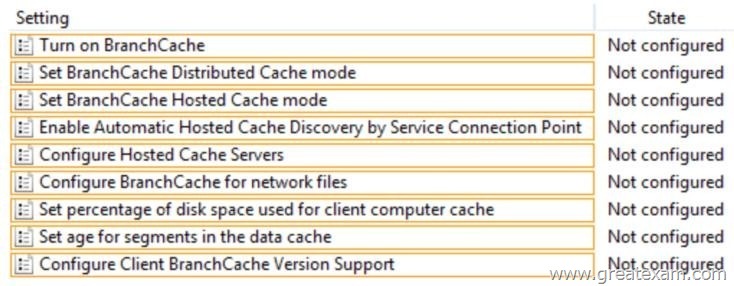
Answer: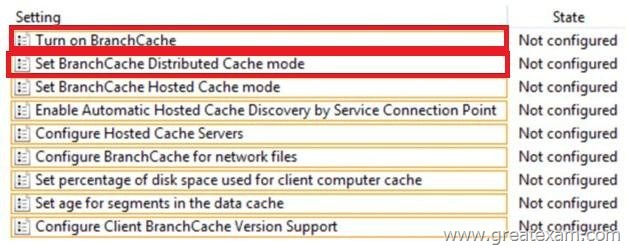
Explanation:
http://technet.microsoft.com/en-us/library/dd637820(v=ws.10).aspx
QUESTION 119
You have a server named Server 1 that runs Windows Server 2012 R2. Server1 has five network adapters. Three of the network adapters are connected to a network named LAN1.
The two other network adapters are connected to a network named LAN2.
You create a network adapter team named Team1 from two of the adapters connected to LAN1.
You create a network adapter team named Team2 from the two adapters connected to LAN2.
A company policy states that all server IP addresses must be assigned by using a reserved address in DHCP.
You need to identify how many DHCP reservations you must create for Server1.
How many reservations should you identify?
A. 2
B. 3
C. 5
D. 7
Answer: B
Explanation:
3 adapter on LAN 1
2 adapters on LAN 2
2 adapters on LAN 1 used in a team, so that’s 3 – 2 leaving 1.
2 adapaters on LAN 2 used in a team, so that’s 2 – 2 leaving 0.
1 team on LAN 1 + 1 team on LAN 2 + remaining adapter on LAN 1 = 3.
QUESTION 120
Your network contains an Active Directory domain named contoso.com.
The domain contains a server named Server1 that runs Windows Server 2012 R2.
Server1 has the IP Address Management (IPAM) Server feature installed.
IPAM is configured currently for Group Policy-based provisioning.
You need to change the IPAM provisioning method on Server1.
What should you do?
A. Run the ipamgc.exe command.
B. Run the Set-IPAMConfiguration cmdlet.
C. Reinstall the IP Address Management (IPAM) Server feature.
D. Delete IPAM Group Policy objects (GPOs) from the domain.
Answer: C
Explanation:
You cannot change the provisioning method after completing the initial setup.
We offer standard exam questions of Microsoft 70-412 practice test. The standard exams are important if you have never taken a real exam. The accuracy of the Q&As are fully guaranteed and the number is enough to impact you passing the exam.